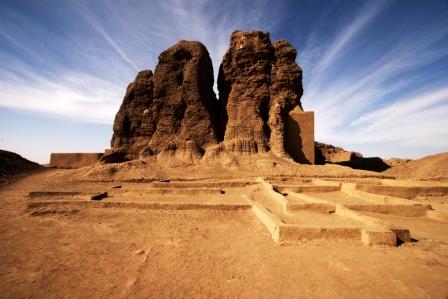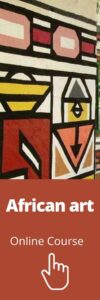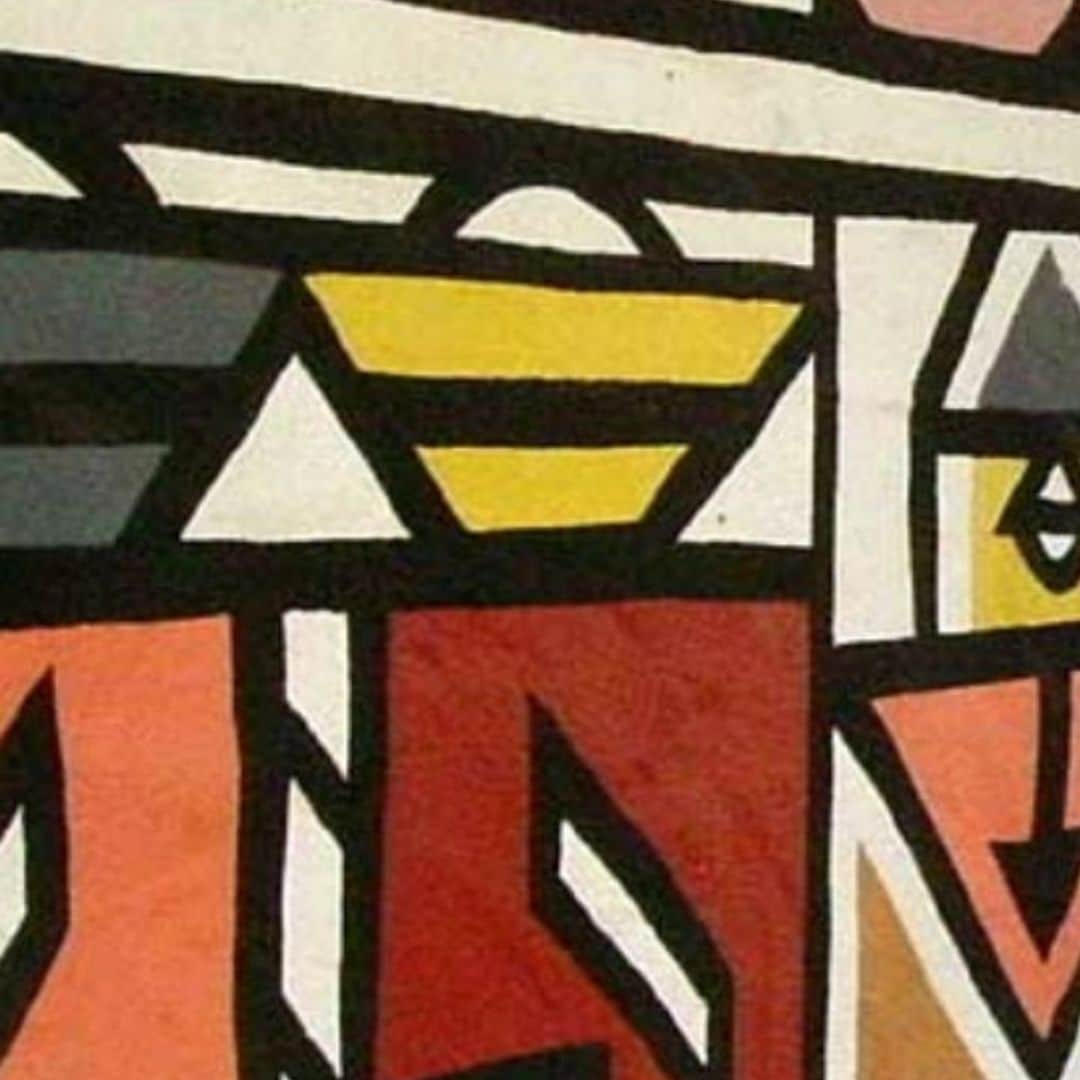To talk about the Art of Africa and the history of african art takes us back to the origins of humanity.
The cradle of civilization, the first signs of human cognition, of interacting with the material world and creating visual symbols that represent and interpret them.
First words about the course African Art by Manuela Tenreiro.
the art of Africa | the origins of art
When we talk abot the art of Africa let us consider that we are talking about hundreds of thousands of years when human consciousness evolved in isolation from the rest of the world.

Petroglyph with lion and giraffe, TwyfelSourcein, Namibia.
Source: https://commons.wikimedia.org/wiki/File:Lion_TwyfelSourcein_Namibia.JPG
From the Rift Valley in today’s Kenya and Tanzania, the first modern human migrations spread to the whole of the African continent.
An extension covering about 30 million square meters -, creating the first language groups, the four proto-languages from which the about 2000 native languages spoken today in Africa originated.
The artistic ability and the recognition and representation of the environment found in rock art throughout Africa are proof that art, like humanity, was born in Africa.
african art history
It is important to emphasize the longevity of the history of art in Africa because including the art of africa in the History of Art is recent.
History of Art as a field of study created in the 18th century was essentially Eurocentric, placing African art and the art of other continents in the fields of anthropology and archaeology.
This was a strategy in tune with the mentality of the time when European nations were asserting themselves as colonizing powers and taking responsibility for the so-called civilizing missions.
Scientific theories that placed European men on top of a biological and cultural hierarchy of races justified this.
Politics and science mutually supported each other in the formulation of theories to facilitate the scramble and colonization of Africa determined by the Berlin Conference of 1884.
For historians of art, focused on European art production and aesthetics, african art appeared suddenly, initially by the hand of anthropologists and European collectors-
And later in the artistic revolution that inspired modern painters and sculptors from around the world, leading them to break the aesthetic norms that up to then guided European concepts of art.
the art of Africa | the african antiquity

Deffufa Temple, Kerma, Kingdom of Kush, 3,000 BCE, Sudan,
Source https://commons.wikimedia.org/wiki/File:Western_Deffufa_-_Kerma.jpg
The development of archaeology after the 19th century gave glimpses into an Africa that didn’t fit the primitivism where Europe had placed it.
Therefore, science removed Egypt, so to speak, from the African continent, interpreting and conceiving it as the birthplace of Western civilization, separated from an origin of cultural interaction with black Africa.
However, during the 20th century, we learned that Egypt had its origins in Africa, in the communities that inhabited the Nile.
We also learned that Africa thrived with urban centers, majestic cities, powerful kingdoms, trade routes from North to South, East to West, mining and monumental constructions.
Little by little, through the multidisciplinary collaboration of various sciences such as history, archaeology, anthropology, genetics and natural sciences, it has been possible to reconstruct the history of art in Africa.
To sum up, to talk about the art of Africa and the history of african art is a monumental task.
The chronological and spatial scope, and the frequently polemic issues surrounding the art of Africa only allows a general overview here.
One that includes as many cultures, mediums, materials, representational styles, influences and periods as possible, with little space for deeper developments.
The idea is not to emphasize some African civilizations over others, but rather to account for the enormous cultural diversity that African art represents to humankind.
We hope, however, that this general overview arouses the curiosity of readers and leads them to further studies and research of specific cultures and periods for their own personal enrichment.
the art of Africa | course structure
The african art course structure has four parts, in a chronological sequence filled with the art of Africa – artistic productions of important african cultures in different geographical regions.
first part – Art of Africa (Rock Art)
The first part deals with the oldest form of artistic expression known to humankind: rock art .
From the South African caves, where the first artistic practices developed to the abundant rock art sites in the Sahara region, the first part ends 5000 years ago with the transition to sedentism in the Nile region forced upon desert peoples by the desertification of the Sahara.
second part – Art of Africa (African Antiquity)
The second part starts with the first sedentary cultures in the Nile and Niger rivers, the first urban centers, the development of ironwork communities and the artistic traditions of these first civilizations.
It covers the last thousand years of what in recent decades became termed as BCE (Before Common Era – previously called b.C. or before Christ).
The second part deals with the formation, ascension and fall of Egypt, the Kingdom of Kush (or Nubia as the Egyptians called it and how it became known to westerners), and the expansion of the Bantu peoples from today’s Cameroon to central, eastern and southern Africa.
third part – Art of Africa (Christianity and Islam)
The third part covers the first 1500 years of the Common Era (CE) and approaches the development of Christianity and Islam in Africa.
It encompasses the birth of the Christian kingdom of Axum (or Ethiopia as the Greeks called it, and the name it adopted).
The expansion of Islam throughout northern and eastern Africa, and ends with Portuguese arrival and the conversion of Kongo to Catholicism at the end of the 15th century.
(Kongo and not Congo, as agreed by historians of Africa to distinguish Kongo’s ancestral culture from modern day state of Congo - even because the latter includes part of today’s Congo and Angola).
fourth part – Art of Africa (from the moment Europeans arrived to early 20th century)
Finally, the fourth part overlaps chronologically with the third sometimes, summarizing the art produced by great empires, kingdoms, cities and cultures from the moment Europeans arrived.
And the beginning of the Atlantic slave trade that marked the start of the Modern Era.
It ends in the late 19th century, early 20th century, when European powers divided and colonized Africa and African art works became part of the European art market, influencing western artists.
What students say about African Art online course
AFRICAN ART what students say about the course by fatima.muralha

Manuela Tenreiro
PhD in History of Art at the School of Oriental and African Studies, I specialized in Arts and Cultures of the African Diaspora in 2008. Previously, I obtained a bachelor degree in visual arts and photography from San Francisco State University, while working as a docent at Diego Rivera’s Pan-American Unity mural (City College). Creator, editor and translator of the online publication conTRAmare.net while residing in Brazil between 2008 and 2017, I collaborated in various editorial and art education projects, as a writer, translator and researcher. In Rio de Janeiro, I attended Literary Translation courses and the Advanced Program of Contemporary Culture at the city’s Federal University. In 2017, I returned to my hometown, Lisbon, where I manage a private art studio with women artists and develop projects writing and translating art history projects.

